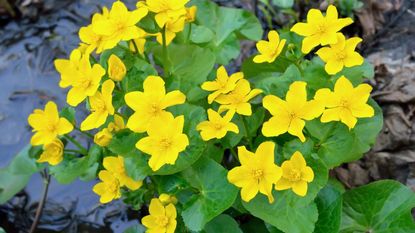5 Marsh Marigold Lookalikes – And Which Cause The Most Harm
Marsh marigolds have several lookalikes, and some of these lovely fast-growing plants can be harmful and invasive. It’s good to know the difference.


Marsh marigold plants, or Caltha palustris, are native throughout much of the United States. Large numbers of the flower can be seen in bloom in early spring. Though its common name is often a source of confusion, marsh plants are not related to other popular garden varieties of marigold, such as Calendula and Tagetes types. Other very similar imposters can be found growing wild.
Swamp marigolds are best known for their glossy, heart-like foliage and bright flowers. Under ideal conditions, short-statured plants will multiply to form expansive colonies. As their name indicates, marsh flowers are most likely to be found growing where soils remain consistently moist. This includes swamps, along ditches, near rivers, and in other low-lying areas.
As with many of their most common lookalikes, marsh marigold plants are considered toxic. Below, we will explore several species that are frequently mistaken for the plant, and examine how to identify each in greater detail.
Identifying the Most Common Marsh Marigold Lookalikes
1. Chrysogonum virginianum
Also known as “green and gold,” Chrysogonum virginianum is a perennial native plant, hardy to USDA zones 5-9. Green and gold is commonly used in the home landscape, more specifically, as a ground cover. These plants thrive in beds that drain well, and are shaded throughout the hottest parts of the day. Within their native range, Chrysogonum virginianum is most likely to be found growing in clearings or near woodlands.
2. Ficaria verna
Though swamp marigold plants can spread, they are not considered invasive in most regions. The same cannot be said for Ficaria verna, or lesser celandine. Established plants multiply quickly, growing to form dense, matted tangles that overtake or choke less vigorous native species. Lesser celandine foliage does resemble that of marsh marigold, though the flowers will differ slightly. Experts advise against the use of this plant in the home landscape, as it is easily able to escape beds and borders.
3. Geum radiatum
Also known as Appalachian avens, Geum radiatum is native to very specific regions of the United States. These plants are most commonly found growing near cliffs or rocky areas along mountaintops. In recent years, the species has become increasingly rare, and is considered to be endangered in most regions.
4. Hypoxis hirsuta
Another common native plant, Hypoxis hirsuta is a low-growing flower, frequently found in fields and near partially wooded areas. Short, grass-like foliage is likely to go unnoticed until the plant begins to flower. At this time, each produces yellow star-like blooms that are highly attractive to pollinators. Though the plant may spread where conditions are ideal, it is not likely to become invasive.
Gardening tips, videos, info and more delivered right to your inbox!
Sign up for the Gardening Know How newsletter today and receive a free download of our most popular eBook "How to Grow Delicious Tomatoes."
5. Ranunculus acris
Both Ranunculus acris and swamp marigold are true species of buttercup. Still, several characteristics can be used to differentiate between the two. Though both will produce bright yellow blooms, the plants’ appearance and overall growth habit are not alike in a variety of ways. Also known as meadow buttercup, acris types will produce mounds of toothy, fern-like foliage. The arrival of spring marks the production of flowers held above tall, wiry stems, which are of notable difference to marsh species. These toxic plants are often considered invasive, and may require the use of chemical or manual means to control populations.
Which Marsh Marigold Lookalikes Cause the Most Harm?
As a gardener, it can be tempting to grow species known for their ability to establish themselves and spread quickly. However, always take care to avoid those that are considered invasive. Referencing regional laws and regulations, as well as chatting with local agricultural agents before planting can help determine the best course of action. Marsh marigold lookalikes such as Ranunculus acris and Ficaria verna should never be planted in the home landscape.
Frequently Asked Questions
Are Marsh Marigolds Poisonous?
Marsh marigold plants have proven toxic to both people and livestock. As a member of the Ranunculaceae family, the species is known to contain protoanemonin. Those hoping to grow the plant should take special caution, specifically, where gardens may be frequented by children and/or pets. Handling these plants also requires care, as direct contact to the skin has been shown to produce symptoms such as minor irritation or even rash.

Tonya Barnett has been gardening for 13 years. Flowers are her passion. She has trasformed her backyard into a cut flower garden, which she regularly chronicles on her YouTube channel http://www.youtube.com/@tonyawiththeflowers.
-
 When To Clean Up Garden Beds In Spring To Protect Pollinators
When To Clean Up Garden Beds In Spring To Protect PollinatorsEvery spring, I'm reminded that many species of insects have used my garden as a winter hotel and may not be ready for a wake-up call just yet.
By Teo Spengler
-
 Cheap Fence Ideas For A Pretty And Private Yard
Cheap Fence Ideas For A Pretty And Private YardYou don’t need to spend a fortune to box in your garden. Take these cheap fencing ideas for your garden and budget and run with them.
By Mary Ellen Ellis
